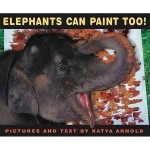Tales for Very Picky Eaters
 Most of you kids’ book fans have heard of the Newbery Medal (given to an author of the most distinguished contribution to literature) and the Caldecott Medal (given to the artist of an outstanding picture book) awarded every year by the American Library Association, but you may not have heard of the Geisel Award given to “the most distinguished American book for beginning readers”. So if you’re looking for a great book for a young reader, the Geisel Award is the perfect place to start!
Most of you kids’ book fans have heard of the Newbery Medal (given to an author of the most distinguished contribution to literature) and the Caldecott Medal (given to the artist of an outstanding picture book) awarded every year by the American Library Association, but you may not have heard of the Geisel Award given to “the most distinguished American book for beginning readers”. So if you’re looking for a great book for a young reader, the Geisel Award is the perfect place to start!
This year’s winner: Tales for Very Picky Eaters written and illustrated by Josh Schneider. I knew I loved this book as soon as I read the “check yes or no” quiz on the inside flap: “Lumpy oatmeal makes me gag.” “I am repulsed by mushroom lasagna. It smells funny.” “Eggs are slimy and I will not eat them.” James is served such undesirable foods by his father, who has very good reasons for giving them to his son. The oatmeal the father bought is Growing Oatmeal, and if the Growing Oatmeal isn’t eaten, it may grow out of control. Mushroom lasagna is made by a troll in the basement who doesn’t want to return to his previous job at the rat circus. And you’ll never guess why James should eat the eggs!
I can think of several “picky eater” books this would be great to compare to: Green Eggs and Ham by Dr. Seuss, I Will Never Not Ever Eat a Tomato by Lauren Child, Little Pea written by Amy Krouse Rosenthal and illustrated by Jen Corace, and of course The Monster Who Ate My Peas written by Danny Schnitzlein and illustrated by the world’s greatest illustrator (and world’s best husband) Matt Faulkner. Read two books about picky eaters with little ones and compare the problems (what wouldn’t this character eat and why) as well as the solutions. Try bringing in some of the fearsome foods and see who in your class will taste a pea! You’ll be teaching the Common Core State Standard of Integrating Knowledge and Ideas, and perhaps tickling a taste bud or two.
Read MoreShades of People
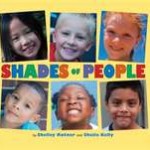 Peach, coffee, cocoa, copper, tan, ivory, rose, almond. So many Shades of People in this gorgeous book by Shelley Rotner and Sheila M. Kelly! I can think of no better book to read to little ones in celebration of Reverend Dr. Martin Luther King, Jr. Day. I’ve tried reading his biography in the past to kindergartners, only to have it go over many heads. This year, I’ll share Dr. King’s message of peace and acceptance with Rotner and Kelly’s spot-on writing and exquisite photographs, followed up with a fun art activity.
Peach, coffee, cocoa, copper, tan, ivory, rose, almond. So many Shades of People in this gorgeous book by Shelley Rotner and Sheila M. Kelly! I can think of no better book to read to little ones in celebration of Reverend Dr. Martin Luther King, Jr. Day. I’ve tried reading his biography in the past to kindergartners, only to have it go over many heads. This year, I’ll share Dr. King’s message of peace and acceptance with Rotner and Kelly’s spot-on writing and exquisite photographs, followed up with a fun art activity.
“Have you noticed that people come in many different shades? Not colors, exactly, but shades.” Rotner and Kelly open the door to discuss skin colors in the most lovely of ways, with photographs of smiling children. Children with golden skin, with freckles, with lusciously dark skin, with rosy pink cheeks. “Our skin is just our covering, like wrapping paper. And, you can’t tell what someone is like from the color of their skin.”
So before you read this book, wrap it up in paper so the cover can’t be seen. Hold it up for your kids to guess what the book is about. Can’t tell what’s inside just by looking at the wrapping? Just like a present! And, just like a person! Read Shades of People with your kids and talk about the descriptive adjectives. How would you describe your skin? I’m sort of peachy-ivory – how about you? After you’ve read and enjoyed the book, get out the paint and let kids paint pictures of themselves. Let them experiment with mixing colors to match their skin tones. Even if you only have the basic primaries, it’s a good science and art experiment to add a bit of red and yellow and even blue to white and black and brown. Celebrate all the colors in your classroom!
For more information, visit shelleyrotner.com.
Read MoreAre You a Horse?
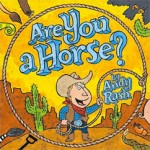 Roy gets a saddle for his birthday with the instructions to find a horse and enjoy the ride, but Roy doesn’t know what a horse is. Are You a Horse? by Andy Rash had my group of kindergartners giggling and chiming in each time Roy asked a different character his big question. “Are you a horse?” Roy asks a cactus, but it can’t be a horse because it’s not an animal. Roy asks a snake, but even though it’s an animal, it can’t be a horse because a horse has legs. Time after time, Roy uses what he’s learned and finds a new something to ask, “Are you a horse?” only to be told no. Finally he finds an animal that meets all the requirements (an animal with legs, friendly, fast, no stripes, etc.) – yes, it’s a horse! The last page had those kindergartners guffawing, because Roy and the horse do use the saddle to go for a ride, but the horse rides Roy.
Roy gets a saddle for his birthday with the instructions to find a horse and enjoy the ride, but Roy doesn’t know what a horse is. Are You a Horse? by Andy Rash had my group of kindergartners giggling and chiming in each time Roy asked a different character his big question. “Are you a horse?” Roy asks a cactus, but it can’t be a horse because it’s not an animal. Roy asks a snake, but even though it’s an animal, it can’t be a horse because a horse has legs. Time after time, Roy uses what he’s learned and finds a new something to ask, “Are you a horse?” only to be told no. Finally he finds an animal that meets all the requirements (an animal with legs, friendly, fast, no stripes, etc.) – yes, it’s a horse! The last page had those kindergartners guffawing, because Roy and the horse do use the saddle to go for a ride, but the horse rides Roy.
There’s a great deal of “yes/no” information in this book, so it was the perfect story to teach kids how to use a chart as a graphic organizer. I made a chart with all the characters Roy meets (the cactus, the snake, etc.) going down the side. Across the top of the chart were listed all the characteristics that came up in the book: are you an animal, do you have legs, etc. Next, I put the picture of each character on a 3×5 card. To make sure I had enough for everyone in the class, I made three cards for each character. I passed out the index cards and asked the kindergartners to find the people who had matching cards (the cards had both the picture and the words to help my non-word-readers). Once the kids were sitting with their character buddies, we filled out the chart together on the Smart Board.
“Are you an animal? Cactuses, thumbs up if yes you are an animal, and thumbs down if you’re not.” Because the kids were in little teams, they could look to each other to answer the question. “Noooo!” Since the cactus did not meet the animal requirement, we wrote the word “no” with a frown face in that square. “Crabs, are you an animal?” Thumbs up meant we wrote the word “yes” with a smiling face in that square. If we weren’t certain (do crabs lay eggs? Good question!) we marked those squares with a question mark and decided to find out the answer during library time. As a group, we used the chart to review and organize all the information we’d learned in reading Are You a Horse? and all the students were actively involved. My animal-loving “nature smart” kids were thrilled, my “logic smart” kids were in heaven, and I had a blast listening to a classroom of kindergartners asking in their best cowboy drawl, “Are you a horse?”
For more information, visit Andy Rash’s website: rashworks.com.
Read More
Little Pink Pup
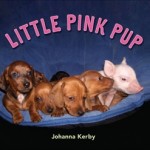 This book makes me squeal with delight! It’s Little Pink Pup by Johanna Kerby and it’s my new favorite non-fiction book. Pink was the smallest of twelve new piglets. He was so tiny that he couldn’t push his way past his siblings to get to his mother, and he ended up cold and hungry in the barn. His owners brought Pink into the house in hopes that Tink can help him. Tink was a dachshund mama with babies of her own to feed. When she saw little Pink, Tink cuddled him in close and treated him like one of her own puppies. The photos of the little brown puppies and the little pink piglet snuggling in or playing together are cute beyond words. The last photo in the book showing a healthy, full grown Pink and his teeny but proud dachshund mama makes me happier than a pig in mud. It’s such a great story, and it’s a fantastic example of how engaging well-written informational books can be. Every kid I’ve shared this book with has swooned over little Pink and his doggy foster family, and I’m wondering how many holiday wish lists in my town had “piglet” added to them (sorry, parents!) You may not be in the market to bring home a hog, but you’ll definitely want to pick up Little Pink Pup to share with your little ones.
This book makes me squeal with delight! It’s Little Pink Pup by Johanna Kerby and it’s my new favorite non-fiction book. Pink was the smallest of twelve new piglets. He was so tiny that he couldn’t push his way past his siblings to get to his mother, and he ended up cold and hungry in the barn. His owners brought Pink into the house in hopes that Tink can help him. Tink was a dachshund mama with babies of her own to feed. When she saw little Pink, Tink cuddled him in close and treated him like one of her own puppies. The photos of the little brown puppies and the little pink piglet snuggling in or playing together are cute beyond words. The last photo in the book showing a healthy, full grown Pink and his teeny but proud dachshund mama makes me happier than a pig in mud. It’s such a great story, and it’s a fantastic example of how engaging well-written informational books can be. Every kid I’ve shared this book with has swooned over little Pink and his doggy foster family, and I’m wondering how many holiday wish lists in my town had “piglet” added to them (sorry, parents!) You may not be in the market to bring home a hog, but you’ll definitely want to pick up Little Pink Pup to share with your little ones.
I’m not the only one feeling the love for Little Pink Pup; it just won the 2011 Children’s Choice Book Awards for Kindergarten – 2nd grade! If you go to author Johanna Kerby’s website, you can see tons of pictures of mama Tink, not-so-little-now Pink, and more of Kerby’s farm animals. I love that this book is a true story of acceptance illustrated with photos taken by the family. Have your little ones bring in family pictures to use as writing prompts – pictures of themselves as babies, pictures of their pets, etc. all will inspire great storytelling and writing. If family photos aren’t an option, consider taking photos in your classroom or library with a digital camera and printing them off to use as story prompts.
I hope that 2012 brings you all peace, joy, and plenty of great children’s books! I am so grateful to share my favorites with you!
For more information about Little Pink Pup, visit johannakerby.com.
Read MoreSo Few of Me
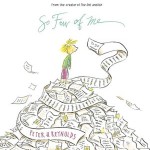 “Leo was a busy lad. No matter how hard he worked, there was always more to do.” This time of year, I can totally relate to Leo in Peter H. Reynold’s wonderful book, So Few of Me. Some days, I wish I had what Leo had to help – another Leo. In fact, the busier he gets, the more Leos show up to lend a hand. But, more Leos find more and more things that need to get done. By the time the tenth Leo shows up to tackle the ever-growing to-do list, original Leo needs a nap, even though “dreaming was NOT on the list!” Leo realizes, “what if I did less – but did my BEST?” and gives himself time to dream.
“Leo was a busy lad. No matter how hard he worked, there was always more to do.” This time of year, I can totally relate to Leo in Peter H. Reynold’s wonderful book, So Few of Me. Some days, I wish I had what Leo had to help – another Leo. In fact, the busier he gets, the more Leos show up to lend a hand. But, more Leos find more and more things that need to get done. By the time the tenth Leo shows up to tackle the ever-growing to-do list, original Leo needs a nap, even though “dreaming was NOT on the list!” Leo realizes, “what if I did less – but did my BEST?” and gives himself time to dream.
Even little ones can relate to that overwhelmed feeling Leo feels in So Few of Me. Leo’s strategy of to-do lists is a good one to model and teach our kids. Now when I do storytimes, even with the 2-year-olds, I have a list that they can see of all the things that will happen during our time together. I made strips with words and pictures that say things like “book” and “song” and I hot-glued magnets to the back so I can stick them on my white board (I save the free magnets from pizza parlors and insurance agents to cut up and glue on). I pull off each activity as we do it so little ones can see how our time is passing. This visual plan is especially helpful for those who have trouble with transitions.
When my own kids were little and we had errands to run, it helped them to have a list for them to hold where they could check off items as we accomplished them. To avoid frustration (and meltdowns at the grocery store or bank), I tried very hard not to squeeze in “just one more” errand and instead I’d stick to the list. Encourage your little ones to make and use lists of pictures and words. Don’t forget to save room on your to-do list for dreaming!
For more information, visit peterhreynolds.com.
Read MoreFrosty the Snowman!
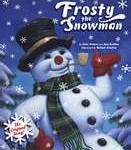 When I sing to my own ‘tweenage kids, they roll their eyes and beg me to stop. But when I sing to preschoolers and kindergartners, I get instant engagement. That’s why I love books that can be sung, like Frosty the Snowman written by Steve Nelson and Jack Rollins and illustrated by Richard Cowley. When I opened this book and started to sing the words to my kindergarten classes, immediately I had kids singing along (including one sweet girl who knew none of the words but still sang “laaa laaa la la laaa!” with vigor and obvious enjoyment.) Fidgeting stopped, and swaying in time to the music began. Eyes followed each page turn. And when I was done reading Frosty the Snowman, eager hands reached for it so they could sing-read it themselves.
When I sing to my own ‘tweenage kids, they roll their eyes and beg me to stop. But when I sing to preschoolers and kindergartners, I get instant engagement. That’s why I love books that can be sung, like Frosty the Snowman written by Steve Nelson and Jack Rollins and illustrated by Richard Cowley. When I opened this book and started to sing the words to my kindergarten classes, immediately I had kids singing along (including one sweet girl who knew none of the words but still sang “laaa laaa la la laaa!” with vigor and obvious enjoyment.) Fidgeting stopped, and swaying in time to the music began. Eyes followed each page turn. And when I was done reading Frosty the Snowman, eager hands reached for it so they could sing-read it themselves.
Books that can be sung are perfect to support early readers because they can easily memorize the words and then use that knowledge to match the words they see on the page with what they already know. Frosty the Snowman also has that great, catchy part at the end: “Thumpity-thump-thump, thumpity-thump-thump.” After we read the book, we practiced patting that rhythm on our knees. You can count it as “1-2-3, 1, 1, 1-2-3, 1,1”. For a listening activity that involves movement, you can make up easy patterns for your little ones to hear and copy: “1, 2, 1,2” or “A, B, A, B”. It can become a sequencing activity and a “reading patterns” lesson. I’ve had kids tap out rhythms we write on the board in words: “knees, head, knees, head” or you can assign letters, colors, etc. Kids can read the pattern, predict how it continues, and then tap out the rhythm with hands, pencils, or chopsticks (I asked my local Chinese restaurant to donate 30 pairs and they gave me a huge bagful! Thanks, Golden Buddha!)
Follow up the listening/sequencing activity with a drawing/writing activity. Give students a sheet of paper with this written at the top:
Frosty the Snowman was a jolly, happy soul
With a _________ and a ________ nose and two eyes made out of ________.
Little ones can draw a snowman and fill in the blanks. With so many fun ways to use this book, Frosty the Snowman is sure to warm your kids’ hearts.
Elephants Can Paint, Too!
I’m trying to use more non-fiction in my storytimes, so when I found Elephants Can Paint, Too by Katya Arnold, I felt like I’d hit the jackpot. Katya Arnold shows in amazing photos her two different painting classes, one for children and one for elephants. It’s so fun to see on one page a young boy holding a brush in his hand and painting a mural of brightly-colored dots, and on the next page, a similar dot painting being made by an elephant with a brush wrapped tightly in her trunk! There’s large, minimal text for young listeners and more informational text for older readers, but all ages will be astounded by the beautiful art elephants can paint.
The best extension you can do after sharing this book with kids is to let them paint! Get out the watercolors! Try the fingerpaints! (Did you know that if you mix food coloring in with corn syrup, you can make your own edible fingerpaint? Yum!) To exercise both hemispheres of the brain, try painting with your non-dominant hand – just leave the nose-painting to the elephants!
Read More



